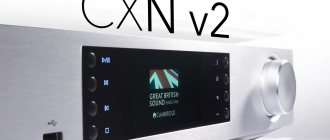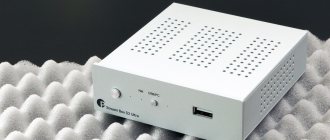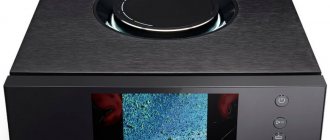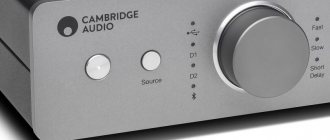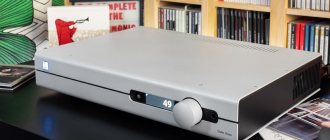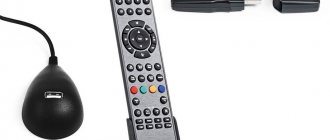Old new player
Both devices from the British Cambridge Audio belong to the CX series, which is in the very center of the catalog - below the 850 series, but above the AX series. The source in our connection was the CXN network player - not a new model, which managed to win awards in the specialized (and what is typical - not only in the British) press and survived one reincarnation until CXN v2.
The device is praised and loved for good reason, indeed, there is a reason for it: built-in Airplay, Chromecast and an external USB Bluetooth module with aptX allow you to quickly connect to any gadget and at the same time have high sound quality, the device itself works with Tidal, reads files from flash drives and The NAS understands all major formats up to DSD64 (not a lot, but still!), and is also Roon-compatible, acting as a playback device.
Plus, there are balanced outputs and the ability to connect external digital sources, including a computer. In a word, almost all the current needs of a modern high-fi player have been taken into account and included. Personally, the only thing I was missing was Deezer, but the manufacturer provides enough alternative ways to solve this problem.
Among the subtleties of the hardware, it is worth noting the presence of a proprietary second-generation ATF2 upsampling algorithm, which increases the resolution of all incoming digital signals to 24 bit/384 kHz. However, after this the signal goes to a pair of old-school Wolfson WM8740 DACs operating in differential mode. The chip is generally good, but is limited to a maximum frequency of 192 kHz and does not have native DSD support. This fact can be taken as a basis for righteous anger directed at the developers, but numerous happy owners of the CXN player of the first and second versions may not agree with the results of this armchair examination.
Cambridge CXN/CXA80 review. Gramophone magazine
Experiments with various speaker systems suggest that in most cases the amplifier's power is more than sufficient: it drives large floor-standing speakers with the same aplomb as compact stand-mounted models. And the extensive network player/DAC/preamp capabilities make the CXN a true value buy in a rapidly growing market
Save and read later -
The name of the new models may look somewhat stripped down - not Cambridge Audio, but simply Cambridge - but as far as their sound quality and functionality are concerned, there is no hint of a reduction here!
Cambridge is considered by some to be a second-rate brand in the world of hi-fi. Due to its focus on producing low-cost amplifiers, CD players, etc. the company has gained a reputation as a “budget company.” With the release of the flagship Azur 851 line, the situation has changed somewhat and the company has acquired a new identity. The new CX series, which includes the CXN network player and the CXA80 amplifier, is called Cambridge for short and features a new logo and brand identity.
The packaging features the motto “Great British Sound since 1968” and stylized flags of the United Kingdom. The same flags and markings appear on the CXN's (£700) home screen, as well as on the front panel labels of all new models. Topping the range is the CXC CD transport (£300), which connects to the digital inputs of the CXN or any of the new range of amplifiers, two of which have built-in DACs, while one, the less powerful CXA60 (£500), has a smaller transformer and lacks balanced analogue inputs and USB, which is included on the CXA80 amplifier I use (£750). All four compact, elegant models in black or silver have a base that is beveled at the corners, giving the device the appearance of a “floating object.”
Cambridge is a brand of Audio Partnership. Development and design are carried out at the London headquarters, products are manufactured at factories in China, in close contact with British engineers. Based on the original technical ideas of the company's talented employees, Cambridge strives to go its own way where other companies use ready-made third-party solutions. For example, the CXN network player uses Cambridge's own streaming module known as Zander. It's compatible with the Cambridge Connect control app and the company says it's 10 times faster than competing devices.
Running on an Android or iOS device, Cambridge Connect enhances the capabilities of the connected device by making it do much of the labor-intensive work of selecting content from network servers, thereby taking the load off the player.
As well as accessing online content and internet radio via wired or Wi-Fi, the CXN offers Apple AirPlay functionality and the ability to connect to the Cambridge BT100 Bluetooth adapter (£70) for aptX wireless communication with non-Apple devices. There is support for Spotify Connect. The device is equipped with coaxial and optical digital inputs and USB ports (expanding the capabilities of working with the 192 kHz/24-bit format, allowing you to play DSD64 files stored on your computer). Cambridge's proprietary second-generation Adaptive Time Filter upsamples all digital content to 384kHz/24-bit before passing the signal to the Wolfson D/A converter, thereby reducing noise. Signal processing is performed by a 32-bit SHARC processor, which is capable of feeding the analog outputs using an advanced resampling system: the CXN can act as a digital preamp if necessary.
The 80W CXA80 amplifier also features digital coaxial, optical and USB inputs for sending signals to a Wolfson D/A converter. The USB port switches to USB 1.0 (for signals up to 96 kHz / 24 bit) or USB 2.0 (192 kHz / 24 bit) mode. You can use the BT100 Bluetooth adapter with the amplifier. The rear panel contains four analog inputs, a preamplifier output and a subwoofer output, and two pairs of individually switchable speaker terminals. The developers' goal was to remove all unnecessary components in order to simplify the signal path as much as possible to achieve the best sound. After the input stage, all signals are converted to symmetrical to suppress noise. The left and right channels are physically separate but symmetrical to avoid crosstalk and maintain good stereo imaging. The amplifier has a proprietary protection system and automatic level reduction - if you suddenly turn up the volume too much and overload the amplifier.
SOUND
Soon after turning on the system, it becomes clear that the developers' desire to improve the sound of the new series has been crowned with success: the bass has become more powerful, the rhythm is more clearly expressed. Both together and separately, both models sound bright, fresh and informative without any signs of harshness or fragility, the bass is surprisingly spacious and flexible. These devices set the standard in the price category up to £1000! The mobile app makes CXN easy to use, even when using large music libraries stored on a computer drive or NAS server. My library, with a ton of takes in different formats for easy testing, includes about 11,000 items - from MP3 to DSD and DXD, but Cambridge finds everything very quickly, allowing you to immediately play albums, tracks and playlists.
The rhythmicity of both components is particularly evident, for example, when playing Bach's sonatas for violin and harpsichord, recorded on the Linn Records label, performed by Lucy Russell and John Butt, where the clear and rich sound of the instruments is perfectly conveyed. And in major musical formats such as Tchaikovsky's Fifth Symphony performed by the San Francisco Symphony on their own label, the strengths of the CXN and CXA80 are at their best: every section of the orchestra can be distinguished and there is a convincing sense of presence - as if you are in the hall.
But what our system does especially well is, in the language of fellow Hi-Fi journalists, “the authenticity of the presentation” - such a lively and exciting recreation of music cannot fail to impress the listener. Experiments with various speaker systems suggest that in most cases the amplifier's power is more than sufficient: it drives large floor-standing speakers with the same aplomb as compact stand-mounted models. And the extensive network player/DAC/preamp capabilities make the CXN a true value buy in a rapidly growing market.
Prepared from Gramophone magazine, September 2015.
This review has been read 8,362 times
Two channels
To tell the truth, if it weren’t for the desire to listen to the new Cambridges play over the network, the system could have been much more compact. The fact is that in addition to the function of amplifying and switching analog signals, the CXA80 amplifier can do a lot more, threatening the very existence of its colleague. It is equipped with a similar DAC module, has SPDIF, USB-B inputs and even a UAB-A port for connecting a proprietary Bluetooth module. The only ace up its sleeve that CXN v2 has in store is the upsampler. The CXA80 does not have this technology.
When it comes to the construction of the amplifier part, the CXA80 demonstrates entirely classic solutions. A completely traditional class AB is implemented in it at its best. The left and right channels are separated according to the principle of full dual mono, starting with the windings of the power supply transformer, and the transformer itself demonstrates a solid power reserve to avoid voltage sags and the occurrence of characteristic distortions when operating at high volumes.
The amplifier has balanced inputs, boasts a double set of output terminals that facilitate bi-wiring, and adjustable outputs: one for the subwoofer and separate from it, stereophonic for system upgrades or bi-amping.
Tradition and technology
Cambridge CX series of components The Cambridge Audio brand is well known to our readers. Modern technology and the British character of sound, combined with a surprisingly adequate pricing policy, is a formula doomed to success. It is not surprising that the company’s products time after time deserve expert recommendations and confidently win group tests.
It would seem that changing something in the wake of popularity is unnecessary, but no electronic products can remain relevant without constant work on their design, functional equipment and, last but not least, image. Cambridge Audio products have always been distinguished by noble asceticism, and now this trend in the design of electronic components is itself at the peak of fashion. Further improvement affected the logo, from which the word “Audio” disappeared. This is not only a plus for conciseness, but also a reflection of Cambridge's wide range. The campaign’s interests have long been not limited to sound alone; it’s worth remembering at least their wonderful Blu-ray players. By the way, in Russia they are officially available without regional protection and with a number of very interesting functions.
The best start for an updated logo can only be a truly revolutionary series of products. This role is played by a fresh line of CX electronic components. It is aimed at the most pressing task for the moment, namely, the combination of advanced digital and network technologies with those aspects of traditional analog sound reproduction that most music lovers are not ready to give up. A key feature of its audio components is the all-digital interconnect circuitry. Both stereo integrated amplifiers in the series (not to mention AV receivers) are equipped with their own digital-to-analog converters, so that audio information from the sources is transmitted to them via an optical or coaxial digital cable.
A key feature of Cambridge's CX range of audio components is their all-digital interconnection. Both stereo integrated amplifiers (not to mention AV receivers) are equipped with their own digital-to-analog converters, so that the audio information from the sources is transmitted to them via an optical or coaxial digital cable. This approach made it possible to simplify the CXC CD player to the limit, which is essentially a transport of optical disks. Its task is to read the disk with the fewest errors and send the resulting digital stream to an external DAC. Maximum accuracy was achieved thanks to the specialized S3 servo drive, tested on the popular CA 351 and 851 players, which in terms of jitter level and quality of correction is head and shoulders above multi-system solutions now found almost everywhere. With such a wonderful device, you can hold off on consigning your CD cabinet to the dustbin of history and enjoy their sound on a new level.
The Cambridge CXN digital source will help make your home audio system unconditionally modern. This is a true flagship of the range, built on Cambridge's wealth of experience gained from the popular Cambridge Audio Stream Magic. The component is capable of working with all current formats, ranging from basic mp3, up to studio-quality 24-bit/192 kHz recordings in FLAC and WAV files. Connection to the network is carried out both wired and wireless, various Internet radio channels, Spotify, Airplay are available, and work with home servers is carried out using the familiar UPnP protocol. Music from flash drives and external HDDs is played via a standard USB port. There is no direct support for Bluetooth, but the additional Cambridge BT100 module solves this problem, and the popular extension of the aptX protocol, which ensures maximum quality of audio transmission over Bluetooth, has not been left without attention.
The proprietary upsampling technology has not been forgotten, revealing the smallest details of the sound canvas even on relatively old recordings. Digital-to-analog conversion is carried out by a pair of Wolfson WM8740 chips. Low-level outputs are designed in both unbalanced and balanced versions, so the device can be optimally connected to any High-End class kits. The player is controlled by a color LCD display on the front panel, which also serves partly as a decorative function for displaying music album covers. And, of course, there is the free Cambridge Connect App for mobile devices, which makes working with your home audio collection easy and efficient. Cambridge's plans to Russify this product are especially welcome.
Built on top-class analog components with powerful toroidal power transformers, the CXA60 and CXA80 integrated amplifiers combine not only class AB pre- and final parts, but also DACs based on Wolfson WM8740 chips.
Amplifiers have always been Cambridge Audio's strong suit, and the new CXA60 and CXA80 continue this worthy tradition. Built with premium analog components and powerful toroidal power transformers, these integrated devices combine not only Class AB front end and front end, but also a Wolfson WM8740 based DAC.
Thus, you can connect any analogue and digital sources in large quantities to them. Particular attention is paid to compatibility with portable equipment. A 3.5mm mini-jack input is available on the front panel; the additional Bluetooth BT100 module will certainly be useful to all those who prefer a mobile gadget as a music player. Two pairs of reliable screw terminals and a separate subwoofer output ensure smooth operation with any speaker system. The older model is built according to a “dual” mono circuit - different windings of the power transformer are used to power the completely symmetrical right and left channels. The CXA60 model also has a symmetrical channel circuitry, but the power supply is common. The power of the younger model is 60 W per channel, the older one reaches 80 W. In addition, the Cambridge CXA80 is equipped with an analog balanced input and a USB type B port, allowing it to work in tandem with a personal computer as an external DAC or, in fact, an external sound card.
The most massive components of the series are the Cambridge CXR120 and CXR200 receivers. These powerful devices prove that cinema sound can be called Hi-Fi and unleash the full potential of the most advanced home theater audio possible. Both are built according to scheme 7.2. The younger model is equipped with 7 HDMI inputs, the CXR200 receiver has 8 such inputs. Both new products have a pair of HDMI outputs, but in the older model these outputs are completely independent, which allows you to use one of the output ports to serve a second zone. In addition, the CXR200 receiver is equipped with a USB type B port for connecting to a computer. For the first time for Cambridge, the new receivers feature a full-color graphic menu, which, moreover, is translated into Russian. To wirelessly connect mobile gadgets via Bluetooth, you can use the proprietary optional adapter BT100.
In addition to acting as the central hub of a home entertainment system, these devices are poised to completely change the discerning audiophile's attitude toward theatrical components, as they are built on an elemental base identical to that of the best music amplifiers and network players. Functionally, they are also universal; all modern formats of both film sound and high-resolution music are fully supported, including the DSD digital stream. The network uses the same protocols as the Cambridge CXN streamer; the Cambridge Connect App mobile application helps control music. The devices are ready to work with video with 4K resolution, and gadget users will undoubtedly be pleased with the support for Airplay and MHL. The power of the junior model of 120 W per channel (in stereo mode when operating with a load of 8 ohms) can already be considered sufficient for city apartments, and the 200 W of the flagship Cambridge CXR200 receiver is capable of knocking dust out of all upholstered furniture and dusting the neighbors below with whitewash from the ceiling. This is an ideal option for specialized cinema halls in cottages and spacious lofts.
Conclusion:
Cambridge's CX Series components can be used to build anything from a simple CD-based stereo system to a home theater system with the most advanced networking capabilities. But in any case, you can be sure that for the money invested you will get the highest possible quality of your favorite music and films.
Sergey Rakov
Depth and width
Each audition inevitably involves an attempt to find the ideal placement of acoustics in the room and relative to the listening point. The notorious triangle sometimes comes together easily, and sometimes the process of its construction literally confuses you when you cannot decide which option to prefer.
I tested the components in the Pult.ru listening room, where the system was assembled in conjunction with Dali Rubicon 2 acoustics. The problem of choosing a position became especially acute due to the exceptional obedience and responsiveness of the speakers. Rotating the radiation axis and changing the distance from the listener to the system not only made it possible to adjust the depth and width of the stage - they made it possible to operate with these parameters with high accuracy.
I turned the speakers a little inward - the stage became deeper and narrower, moved the chair forward - I found myself in the thick of things. All options are good in their own way, but among them I was never able to find an option that provides holographic accuracy. What was missing was depth, width, or localization accuracy. It probably made sense to double the effort or even move the system to a larger room, but the time allocated for the test is not endless, and listening to music was too interesting.
In the end, I settled on a version with a slightly squeezed on the sides, but a deep soundstage. The bulk of the musical events were located in the space between the listener and the system, but individual sounds flew far away, sometimes even ending up somewhere behind the listening position.
First impressions formed while listening: the system is detailed, accurate and dynamic. The sharpest and fastest sounds are not blurred or slowed down, there are no obvious disturbances in tonal balance, small details are audible even in complex multifaceted musical compositions.
The middle sounds very dense and energetic, the upper ones are transparent and sometimes mercilessly pull out equipment noise, mastering flaws and compression artifacts (if you suddenly decide to listen to MP3). Upper bass is well focused and rhythmic. The character of the music presentation was generally neutral, but not dry. The system pays equal attention to both details and the overall artistic component of the music.
Realism
The nature of the pairing can be well understood by listening to The Cure. This music can hardly be called audiophile in essence: it is more emotional, atmospheric, evoking experiences, rather than a desire to delve into the details of the sound. The combination of Cambridge Audio CXN and CXA80 with the support of Dali Rubicon 2 revealed recordings from different years in an unexpected way. In addition to the general emotional message, many details began to be heard, as if The Cure clips from the 80s and 90s were re-shot in 4K resolution, and now you can see every cobweb in them, which makes it even more exciting and scary.
And since we are talking about rock stars of the late 20th century, it was absolutely impossible to pass by Queen. The sound of “Another One Bites To Dust” turned out to be very elastic, dense, rhythmic and fast. The whole room begins to pulsate in rhythm, your feet are stamping, your fingers are clicking, and you really want to immediately change your black T-shirt to a white T-shirt.
When “Under Pressure” starts playing, you involuntarily freeze and watch with interest the work of two geniuses. The song can be felt to the fullest, and at the same time one can see from the inside a very interesting spatial musical structure.
Going through well-known recordings, I once again drew attention to the fact that the system very reliably conveys not only the nature of the music, but also the nature of the mastering. In one edition of Pink Floyd, the clock in “Time” sounded very loud and harsh, but in another it did not cause any discomfort and was very realistic. When moving to classical music, it was interesting to evaluate the system’s ability to convey the scale of musical works. In the famous piece of “Carmina Burana” with the transition from piano to forte, a good dynamic range was felt, making it possible to feel the magnitude of the emotional intensity. And although, due to the use of shelf acoustics, the system gravitated more towards chamber music, the greatness of the symphonic canvases was quite obvious.
And finally, a life hack for beginning music lovers. Want to understand why Ray Charles is a genius? Take this system and turn on the first hit you come across, or at least “Georgia On My Mind”, but make sure that the further playlist is empty - so that there is time to sit in silence, watch the goosebumps running all over your body, and fully experience what happened to you. No matter how strange it may sound, this song alone can fill and saturate a music lover’s soul with experiences for the day, or even a week ahead.
